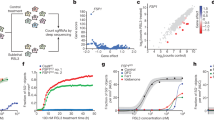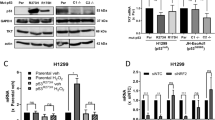Abstract
Loss of p53 gene function, which occurs in most colon cancer cells, has been shown to abolish the apoptotic response to 5-fluorouracil (5-FU). To identify genes downstream of p53 that might mediate these effects, we assessed global patterns of gene expression following 5-FU treatment of isogenic cells differing only in their p53 status. The gene encoding mitochondrial ferredoxin reductase (protein, FR; gene, FDXR) was one of the few genes significantly induced by p53 after 5-FU treatment. The FR protein was localized to mitochondria and suppressed the growth of colon cancer cells when over-expressed. Targeted disruption of the FDXR gene in human colon cancer cells showed that it was essential for viability, and partial disruption of the gene resulted in decreased sensitivity to 5-FU-induced apoptosis. These data, coupled with the effects of pharmacologic inhibitors of reactive oxygen species, indicate that FR contributes to p53-mediated apoptosis through the generation of oxidative stress in mitochondria.
This is a preview of subscription content, access via your institution
Access options
Subscribe to this journal
Receive 12 print issues and online access
$209.00 per year
only $17.42 per issue
Buy this article
- Purchase on Springer Link
- Instant access to full article PDF
Prices may be subject to local taxes which are calculated during checkout





Similar content being viewed by others
References
O'Connor, P.M. et al. Characterization of the p53 tumor suppressor pathway in cell lines of the National Cancer Institute anticancer drug screen and correlations with the growth-inhibitory potency of 123 anticancer agents. Cancer Res. 57, 4285–300 (1997).
Lowe, S.W. et al. p53 status and the efficacy of cancer therapy in vivo. Science 266, 807–810 (1994).
Bunz, F. et al. Disruption of p53 in human cancer cells alters the responses to therapeutic agents. J. Clin. Invest. 104, 263–269 (1999).
Oren, M. Regulation of the p53 tumor suppressor protein. J. Biol. Chem. 274, 36031–36034 (1999).
Prives, C. & Hall, P.A. The p53 pathway. J. Pathol. 187, 112–126 (1999).
El-Deiry, W.S. Regulation of p53 downstream genes. Semin. Cancer Biol. 8, 345–357 (1998).
Giaccia, A.J. & Kastan, M.B. The complexity of p53 modulation: emerging patterns from divergent signals. Genes Dev. 12, 2973–2983 (1998).
Johnson, T.M., Yu, Z.-X., Ferrans, V.J., Lowenstein, R.A. & Finkel, T. Reactive oxygen species are downstream mediators of p53-dependent apoptosis. Proc. Natl. Acad. Sci. USA 93, 11848–11852 (1996).
Polyak, K., Xia, Y., Zweier, J.L., Kinzler, K.W. & Vogelstein, B. A model for p53 induced apoptosis. Nature 389, 300–304 (1997).
Lee, J.M. Inhibition of p53-dependent apoptosis by the KIT tyrosine kinase: regulation of mitochondrial permeability transition and reactive oxygen species generation. Oncogene 17, 1653–1662 (1998).
Li, P.F., Dietz, R. & von Harsdorf, R. p53 regulates mitochondrial membrane potential through reactive oxygen species and induces cytochrome c-independent apoptosis blocked by Bcl-2. EMBO J. 18, 6027–6036 (1999).
Green, D.R. & Reed, J.C. Mitochondria and apoptosis. Science 281, 1309–12 (1998).
Kroemer, G. & Reed, J.C. Mitochondrial control of cell death. Nature Med 6, 513–519 (2000).
Velculescu, V.E., Zhang, L., Vogelstein, B. & Kinzler, K.W. Serial Analysis Of Gene Expression. Science 270, 484–487 (1995).
El-Deiry, W.S., Kern, S.E., Pietenpol, J.A., Kinzler, K.W. & Vogelstein, B. Definition of a consensus binding site for p53. Nature Genet. 1, 45–49 (1992).
Lambeth, J.D., Seybert, D.W., Lancaster, J.R., Salerno, J.C. & Kamin, H. Steroidogenic electron transport in adrenal cortex mitochondria. Mol. Cell. Biochem. 45, 13–31 (1982).
Lin, D., Shi, Y.F. & Miller, W.L. Cloning and sequence of the human adrenodoxin reductase gene. Proc. Natl. Acad. Sci. USA 87, 8516–8520 (1990).
Ziegler, G.A., Vonrhein, C., Hanukoglu, I. & Schulz, G.E. The structure of adrenodoxin reductase of mitochondrial P450 systems: electron transfer for steroid biosynthesis. J. Mol. Biol. 289, 981–990 (1999).
Rapoport, R., Sklan, D. & Hanukoglu, I. Electron leakage from the adrenal cortex mitochondrial P450scc and P450c11 systems: NADPH and steroid dependence. Arch. Biochem. Biophys. 317, 412–416 (1995).
Hanukoglu, I., Rapoport, R., Weiner, L. & Sklan, D. Electron leakage from the mitochondrial NADPH-adrenodoxin reductase- adrenodoxin-P450scc (cholesterol side chain cleavage) system. Arch. Biochem. Biophys. 305, 489–498 (1993).
Yu, J. et al. Identification and classification of p53-regulated genes. Proc. Natl. Acad. Sci. USA 96, 14517–14522 (1999).
Chan, T.A., Hermeking, H., Lengauer, C., Kinzler, K.W. & Vogelstein, B. 14-3-3Sigma is required to prevent mitotic catastrophe after DNA damage. Nature 401, 616–620 (1999).
Masramon, L. et al. Cytogenetic characterization of two colon cell lines by using conventional G-banding, comparative genomic hybridization, and whole chromosome painting. Cancer Genet. Cytogenet. 121, 17–21 (2000).
Yu, J., Zhang, L., Hwang, P.M., Kinzler, K.W. & Vogelstein, B. PUMA induces the rapid apoptosis of colorectal cancer cells. Molecular Cell 7, 673–682 (2001).
Bunz, F. et al. Requirement for p53 and p21 to sustain G2 arrest after DNA damage. Science 282, 1497–1501 (1998).
Pham, N.A., Robinson, B.H. & Hedley, D.W. Simultaneous detection of mitochondrial respiratory chain activity and reactive oxygen in digitonin-permeabilized cells using flow cytometry. Cytometry 41, 245–251 (2000).
Kelso, G.F. et al. Selective targeting of a redox-active ubiquinone to mitochondria within cells: Antioxidant and antiapoptotic properties. J. Biol. Chem. 276, 4588–4596 (2001).
Lill, R. & Kispal, G. Maturation of cellular Fe-S proteins: an essential function of mitochondria. Trends Biochem. Sci. 25, 352–356 (2000).
Manzella, L., Barros, M.H. & Nobrega, F.G. ARH1 of Saccharomyces cerevisiae: A new essential gene that codes for a protein homologous to the human adrenodoxin reductase. Yeast 14, 839–846 (1998).
Li, J., Saxena, S., Pain, D. & Dancis, A. Adrenodoxin reductase homolog (Arh1p) of yeast mitochondria required for iron homeostasis. J. Biol. Chem. 276, 1503–1509 (2001).
Vogelstein, B., Lane, D. & Levine, A.J. Surfing the p53 network. Nature 408, 307–310 (2000).
Asher, G., Lotem, J., Cohen, B., Sachs, L. & Shaul, Y. Regulation of p53 stability and p53-dependent apoptosis by NADH quinone oxidoreductase 1. Proc. Natl. Acad. Sci. USA 98, 1188–1193 (2001).
Meek, D.W. Mechanisms of switching on p53: a role for covalent modification? Oncogene 18, 7666–7675 (1999).
Waldman, T., Kinzler, K.W. & Vogelstein, B. p21 is necessary for the p53-mediated G(1) arrest in human cancer cells. Cancer Res. 55, 5187–5190 (1995).
Zhang, L. et al. Gene expression profiles in normal and cancer cells. Science 276, 1268–1272 (1997).
Feinberg, A.P. & Vogelstein, B. A technique for radiolabeling DNA restriction endonuclease fragments to high specific activity. Anal. Biochem. 132, 6–13 (1983).
Jallepalli, P.V. et al. Securin is required for chromosomal stability in human cells. Cell 105, 445–457 (2001).
He, T.C. et al. A simplified system for generating recombinant adenoviruses. Proc. Natl. Acad. Sci. USA 95, 2509–2514 (1998).
Waldman, T., Lengauer, C., Kinzler, K.W. & Vogelstein, B. Uncoupling of S phase and mitosis induced by anticancer agents in cells lacking p21. Nature 381, 713–716 (1996).
Acknowledgements
We thank L. Meszler for help with cell imaging and all members of the Kinzler/Vogelstein Laboratories for advice and discussion. This work was supported by the Clayton Fund, the Miracle Foundation, and NIH grants CA 43460 and GM 07184. K.W.K. receives research funding from Genzyme Molecular Oncology (Genzyme) and K.W.K. and B.V. are consultants to Genzyme. Under a licensing agreement between the Johns Hopkins University and Genzyme, the SAGE technology was licensed to Genzyme, and K.W.K. and B.V. are entitled to a share of royalty received by the University from sales of the licensed technology. The terms of these arrangements are being managed by the University in accordance with its conflict of interest policies.
Author information
Authors and Affiliations
Corresponding author
Supplementary information
Supplemental Figure A
a, p53 western blot of parental HCT116 (WT), TRP53-/-, FDXR+/+/- (G10, A11) and FDXR+/-/- (C2, D2) cell lines treated (+) with 50 mg/ml 5-FU for 48 h versus untreated (-) samples. b, p21 western blot of parental HCT116 (WT), FDXR+/+/- (G10), FDXR+/-/- (D2, C2) cell lines treated with 0 (for WT only, same baseline for all samples), 30 or 50 mg/ml 5-FU for 48 h. Equal amounts of protein (25 mg) were loaded in each well. (JPG 27 kb)
Rights and permissions
About this article
Cite this article
Hwang, P., Bunz, F., Yu, J. et al. Ferredoxin reductase affects p53-dependent, 5-fluorouracil–induced apoptosis in colorectal cancer cells. Nat Med 7, 1111–1117 (2001). https://doi.org/10.1038/nm1001-1111
Received:
Accepted:
Issue Date:
DOI: https://doi.org/10.1038/nm1001-1111
This article is cited by
-
Targeted activation of ferroptosis in colorectal cancer via LGR4 targeting overcomes acquired drug resistance
Nature Cancer (2024)
-
Critical role of antioxidant programs in enzalutamide-resistant prostate cancer
Oncogene (2023)
-
Cuproptosis: p53-regulated metabolic cell death?
Cell Death & Differentiation (2023)
-
Mechanisms of UV-induced human lymphocyte apoptosis
Biophysical Reviews (2023)
-
The DNA damage response to radiological imaging: from ROS and γH2AX foci induction to gene expression responses in vivo
Radiation and Environmental Biophysics (2023)



